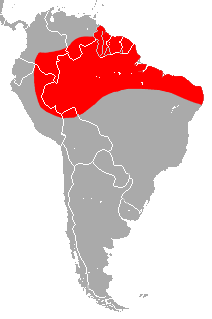
The white-winged dog-like bat is a bat species from South America. It is found in northern Brazil, southeastern Colombia, Ecuador, French Guiana, Guyana, eastern Peru, Surinam and Venezuela.

Thyromolis is a monotypic moth genus in the family Erebidae erected by George Hampson in 1901. Its only species, Thyromolis pythia, was first described by Herbert Druce in 1900. It is found in French Guiana, Guyana, Bolivia and the Brazilian state of Amazonas.

Eriostepta nigripuncta is a moth of the family Erebidae. It was described by James John Joicey and George Talbot in 1918, originally under the genus Araeomolis. It is found in French Guiana, Peru and Bolivia.

Araeomolis rhodographa is a species of moth in the family Erebidae. It was described by George Hampson in 1901. It is found in French Guiana, Venezuela, Colombia, Bolivia, Panama, Suriname and the Brazilian state of Amazonas.
Eriostepta sanguinea is a moth of the family Erebidae. It was described by British entomologist George Hampson in 1905, originally under the genus Araeomolis; Hervé de Toulgoët transferred it to Eriostepta in 1993. It is found in French Guiana, Guyana, Peru, and the Brazilian state of Amazonas.
Baritius cyclozonata is a moth of the family Erebidae. It was described by George Hampson in 1901. It is found in French Guiana, Suriname, Brazil, the Amazon region, Ecuador, Peru and Bolivia.

Coiffaitarctia steniptera is a moth of the family Erebidae first described by George Hampson in 1905. It is found in Costa Rica, French Guiana, Suriname and the Amazon region.

Cratoplastis rectiradia is a moth of the family Erebidae first described by George Hampson in 1901. It is found in Peru, French Guiana, Suriname, the Amazon region and Bolivia.
Dialeucias pallidistriata is a moth of the family Erebidae first described by George Hampson in 1901. It is found in Brazil, Suriname, Ecuador, Peru and Venezuela.
Eriostepta roseireta is a moth of the family Erebidae first described by George Hampson in 1901. It is found in French Guiana, Brazil, and Suriname.

Epimolis incarnata is a moth of the family Erebidae. It was described by George Hampson in 1901. It is found in French Guiana, Brazil, Ecuador and Peru.

Leucanopsis polyodonta is a moth of the subfamily Arctiinae. It was described by George Hampson in 1901. It is found in French Guiana, Brazil and the Amazon region.
Zatrephes flavida is a moth of the family Erebidae. It was described by George Hampson in 1905. It is found in French Guiana.
Zatrephes trilineata is a moth of the family Erebidae. It was described by George Hampson in 1905. It is found in French Guiana, Suriname and Peru.
Pelochyta albipars is a moth of the family Erebidae. It was described by George Hampson in 1914. It is found in Peru, and French Guiana.
Rhipha flammans is a moth in the family Erebidae. It was described by George Hampson in 1901. It is found in Colombia, Brazil, French Guiana, Guyana, Ecuador, Peru and Bolivia.
Scaptius holophaea is a moth in the subfamily Arctiinae. It was described by George Hampson in 1905. It is found in French Guiana, Suriname and Amazonas.
Trichromia albicollis, is a moth in the family Erebidae. It was described by George Hampson in 1905. It is found in French Guiana, Guyana and Bolivia.
Trichromia cyclopera is a moth in the family Erebidae. It was described by George Hampson in 1905. It is found in French Guiana, Guyana, Amazonas and Ecuador.
Zatrephes dithyris is a moth in the family Erebidae found in French Guiana and Ecuador. It was described by George Hampson in 1905.







